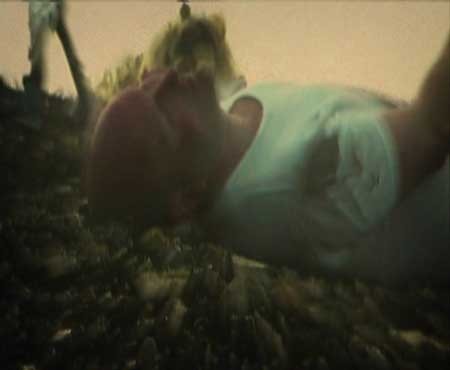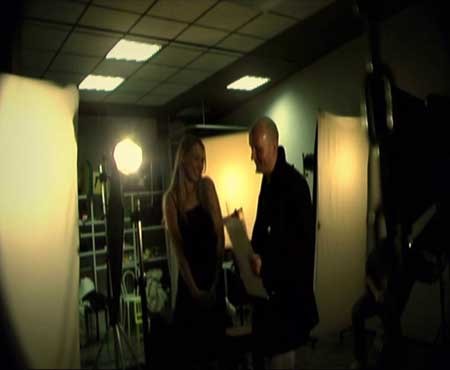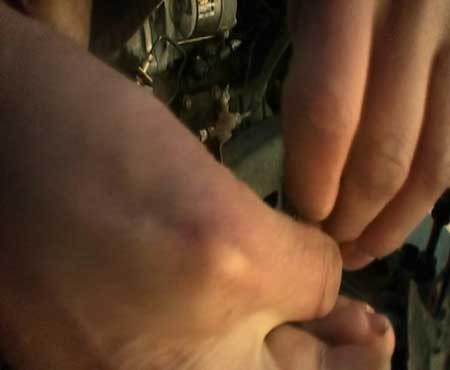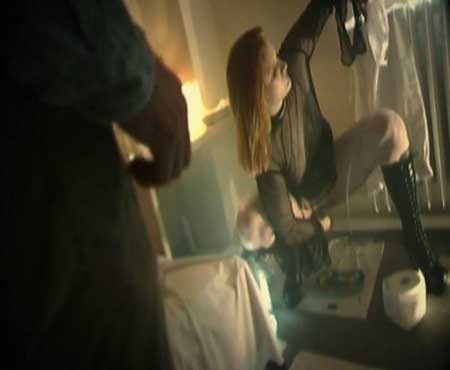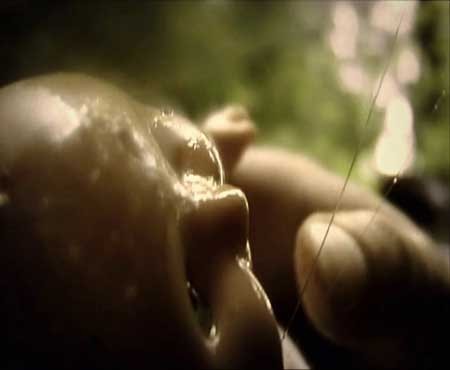SYNOPSIS:
Defecation. Death. Decay. Documentation.
REVIEW:
Most reviews of Debris Documentar follow the same redundant pattern: descriptions of the countless disgusting acts in the film, interspersed with exclamations of how disgusting it all is. If those acts were to be listed here in detail – and this is no exaggeration – there would be no space left for an actual review. This is the debut feature (although it didn’t properly surface until years later) of German filmmaker/public enemy Marian Dora, whose magnum opus remains Melancholie der Engel (2009) – a film which tops “most disturbing films” lists with alarming frequency. For many, Debris Documentar surpasses even that film.
Carsten Frank, who continued his association with Dora in Cannibal (2006) and Melancholie, appears as himself in Debris, although the film is clearly not a documentary. The lack of English subtitles prevents a complete understanding or reliable analysis of the film, but he appears to be a set dresser or propman on a film set. Debris follows Carsten through his daily routines (eating, showering, jogging, working, returning phone calls), juxtaposing this sense of the normal and mundane with endless scenes involving (in relentlessly explicit detail) urination, defecation, regurgitation, masturbation, ejaculation, self-mutilation, genital amputation, an enema, coprophilia, scatophagia, rotting carcasses and disembowelled animals. The guy even picks his nose and eats it.
Debris Documentar is something of a companion piece to Dora’s Melancholie. During the opening credits the title of the film is followed by a line which roughly translates as “Insights into the pre-production of Melancholie der Engel.” Aside from the presence of several actors, both films are unmistakably the work of the same filmmaker; they share a similar visual aesthetic, atmosphere and iconography (rotting remains, dolls, spiders, sphincters), reflecting the same nauseating preoccupations of their maker. But whereas Debris contains much less violence and cruelty, it is stripped of the poetry and philosophical references that provided Melancholie with an otherworldly, even romantic atmosphere.
Instead, Debris aligns itself with a far less highbrow cultural phenomenon. Carsten has a neatly displayed video collection, loaded with horror and exploitation movies, including many video nasties (The Gestapo’s Last Orgy, The Toolbox Murders, Werewolf Woman). Actor David Hess (from video nasty cause celebre The Last House on the Left), whose songs were actually used in Melancholie, makes a brief appearance here, and the voice of king of Eurosleaze Jess Franco (also responsible for several nasties) can be heard on the telephone several times during the film. Video nasty director Ulli Lommel, with whom Dora has collaborated a number of times, also shows up; Carsten Frank’s credits as an actor number several films by both Lommel and Franco.
But back to the poo. Vomit, urination and defecation on camera is nothing new. Dora has declared the influence of many films of the 1970s on his own endeavors. Three landmarks of transgressive cinema of the mid-70s, banned throughout the world (but still remembered and discussed, whether praised or reviled, having reached a much larger audience than Dora’s film), come to mind when experiencing Debris – but each offers some kind of lens through which the shocking material is contextualised. For Debris is not tempered by the political polemics of Salo, the surrealist playfulness of Sweet Movie, or the innocence and tenderness of Vase de Noces (most commonly known by its scandalous and reductive unofficial title The Pig Fucking Movie).
More recently, there are links with fellow countryman Jorg Buttgereit, whose hugely controversial films (such as Nekromantik and Der Todesking) deal with death, decay, mutilation and necrophilia. Dora and Buttgereit are clearly united in some of their obsessions, and their careers (sometimes even their lives) are constantly under threat due to the amount of controversy their work generates. The kinds of movies they are driven to make, unfortunately, are not rewarded by a cultural climate that encourages debate and interpretation of such confronting and repellent material.
But unlike any feature film before it, Debris Documentar filters this deconstruction of death and rot through a meditation on human waste – ironically intensifying the reactions of offended audiences with his method of utterly deglamorizing the processes through which the body rids itself of natural debris. The amount of feces spilled in this film could probably sustain a small country’s farming industry for a year. Carsten also gets off on smelling the interior of his sweaty shoes, jerks off while taking a dump, picks his nose, butthole, scabs and areas between his toes – and eats each and every nugget. This is the human animal at play; Carsten seems quite harmless, and nobody is getting hurt – at least until the descent into violence and sadism toward the end of the film, which contains unbelievably graphic images of sexual violence.
Through it all, Dora revels in challenging the viewer to find beauty in the darkest depths of depravity – where some believe that trying to push the body to its limits is a form of spiritual ascension. As the director himself puts it, you have to put your morality aside in order to engage with his films. It is clear that most viewers, even horror aficionados, are unable or unwilling to do this. If the sights and sounds of the very same bodily functions we are all condemned to perform daily is too much, do not fear – you can always go back to universally accepted forms of entertainment like murder, torture and rape.
Ultimately, with Debris Documentar perhaps Dora’s sensibility is largely informed by the horror movies that line his character’s shelves, and the environment Carsten works in – being part of a film crew and constantly filming his own depraved exploits. The corpses and dead animals he captures on camera hold the same fascination for him as the dolls and other props he works on. It is all simply raw material for his documentary of waste; life is an endless cycle of dirt, excrement, sexual gratification, death and decay. Is our disgust a sign of the success or of the failure of the film? Either way, I am reminded of that definitive slogan which accompanied advertisements for David Hess’ most notorious and incendiary film: It’s only a movie… only a movie… only a movie…
 Horror News | HNN Official Site | Horror Movies,Trailers, Reviews
Horror News | HNN Official Site | Horror Movies,Trailers, Reviews
